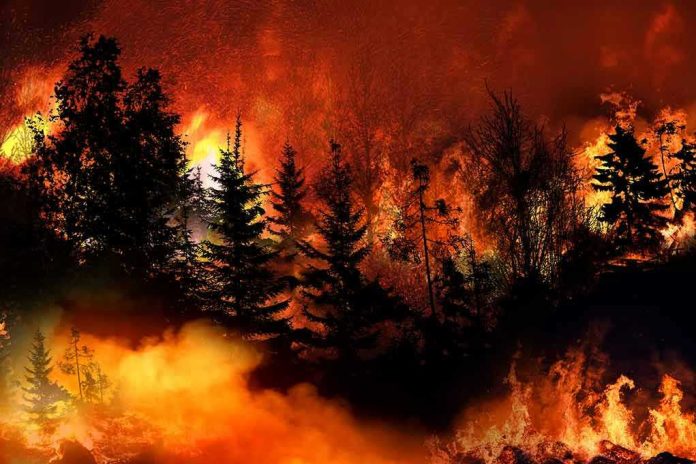
California’s largest wildfire of the year has scorched nearly 80,000 acres, and as smoke chokes the air and sends families fleeing, the public is left to wonder how, in the era of trillion-dollar government budgets, we’re still this unprepared for predictable disaster.
At a Glance
- The Madre Fire exploded to nearly 80,000 acres, making it California’s largest wildfire of 2025.
- Over 200 residents have been forced to evacuate as air quality plummets from hazardous levels of smoke.
- Firefighting efforts are stretched thin with containment at just 10% and over 600 personnel deployed.
- Critical habitats and endangered species in the Carrizo Plain National Monument are under immediate threat.
California Ablaze While Bureaucrats Burn Through Budgets
Another summer, another scorched earth warning for families in California—and another round of shocked faces in Sacramento acting like wildfires are some kind of “unexpected” event. The Madre Fire, which ignited July 2 near Highway 166 outside New Cuyama, has ballooned to nearly 80,000 acres in just three days. The fire’s path ripped east-northeast, fueled by winds and bone-dry brush, quickly invading the Carrizo Plain National Monument. That’s a spot supposedly “protected” by layers of overlapping agencies, but apparently not from the obvious: fire in fire season.
It’s no wonder families are frustrated. California’s government prints money like it’s going out of style, yet when a fire inevitably breaks out, we get the same old story—thin resources, slow response, and the same health warnings about “staying inside” and “using air purifiers.” As if every working family in the Central Valley can just lock their doors and breathe through a $200 mask while their livestock and livelihoods go up in smoke.
Wildfire Grows, Agencies Point Fingers, Residents Pack Bags
By July 5, with containment stuck at a measly 10%, over 200 people had already been forced from their homes. Fifty structures are threatened, one has burned, and entire stretches of rural California are under mandatory evacuation. Over 600 firefighters are on the ground, with nearly 50 engines and multiple air tankers, but the message from officials is the same as always: “The fire remains active and wind-driven,” and the best the public can do is hope for a wind shift or a break in the weather. No word yet on what caused the blaze. Maybe it was a spark, maybe it was yet another “unhoused” camp, maybe a utility line—who knows? What’s clear is that the state’s bureaucratic patchwork of CAL FIRE, Los Padres National Forest, and the BLM means nobody takes real responsibility, and ordinary people pay the price.
Meanwhile, while the fire rages, the smoke doesn’t politely stay put. It’s already drifted into the Los Angeles basin, triggering “hazardous” air quality advisories. Health officials, in a display of government genius, urge people to “limit outdoor exposure” and “use N95 masks.” Any chance those masks are from the same endless stockpile purchased during the pandemic panic? It’s hard to keep track of which disaster our taxes are supposed to have prepared us for.
California’s “Green” Policies Leave Real People in the Red
The Madre Fire is three times the size of the Palisades Fire earlier this year and much larger than the deadly Eaton Fire. What do all these infernos have in common? They’re fueled by years of neglect, poor forest management, and a government more interested in virtue-signaling about climate change than actually protecting property and life. The Carrizo Plain is home to rare wildlife and endangered species, but state and federal agencies have spent years blocking sensible land management—controlled burns, grazing, even brush removal—out of deference to environmental groups with more lawyers than common sense. Now those “protected” habitats are turning to ash, and the only thing left endangered is the taxpayer’s bank account.
Beyond the immediate threat to property and wildlife, the economic fallout is just beginning. Firefighting costs will soar, property losses mount, and farmers—already hammered by water restrictions and regulation—face fresh disaster. Insurance premiums in rural zones are likely to spike again, if companies even stick around to write policies. All the while, Sacramento will blame “extreme weather” and demand more federal bailouts, while refusing to admit that their own policies have made the state a tinderbox.
The Real Cause: Government Negligence Meets Natural Disaster
Fire officials and environmental scientists agree that heat and wind have driven the fire’s rapid growth. But behind the weather lies a deeper problem: a system that promotes endless study, endless regulation, and endless spending—without delivering real results for families and property owners. California’s wildfire season has gotten longer and more intense, but the only thing growing faster than the flames is the pile of paperwork and red tape that stands between communities and real preparedness.
As the Madre Fire continues to burn, the full cost—in property, in health, in lost livelihoods—won’t be clear for weeks. What is clear is that the state’s priorities are upside down. Californians are left to fend for themselves, while politicians in Sacramento and Washington wring their hands and promise “action” after the flames are out and the cameras are gone. Until voters demand accountability and common sense, expect more summers like this one: smoky, dangerous, and paid for by those who get the least in return for their tax dollars.










